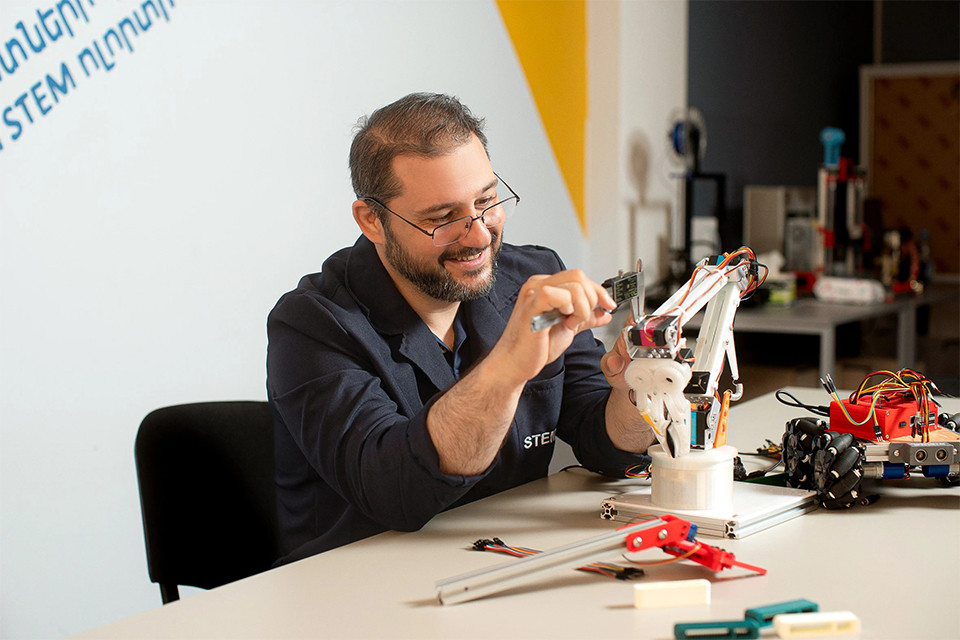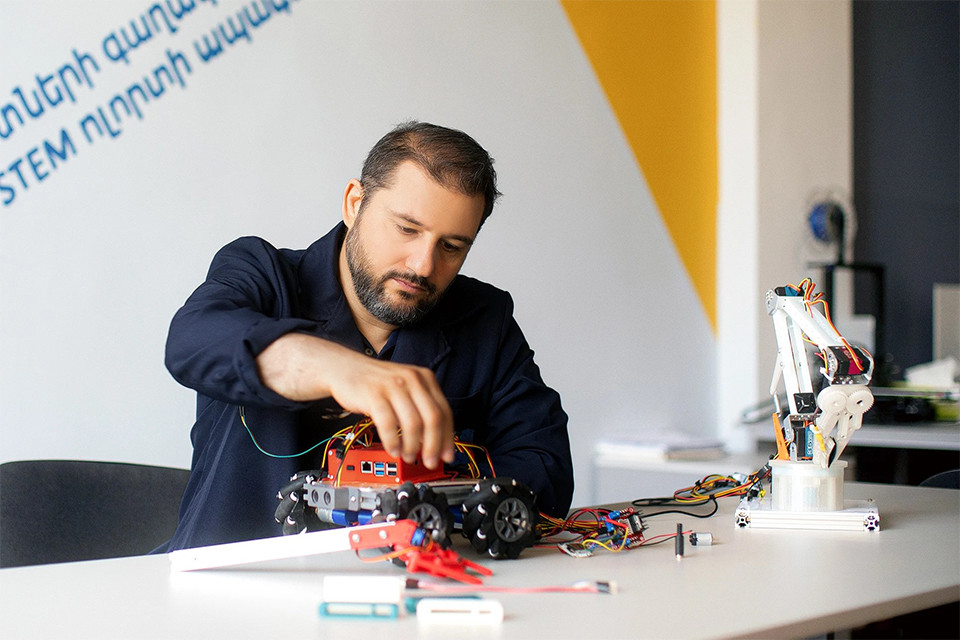-

Hrachya Khachatryan
-

Hrachya Khachatryan
-

Hrachya Khachatryan
13:06 | 31.07.24 | Interviews | exclusive 22617
Hrachya Khachatryan: Scientists are driven by what they don’t know
There are currently substantial preconditions for the development of the engineering sector in Armenia. In the past decade, identification of talents has been mainly carried out among schoolchildren through implementation of programs for different target groups. To ensure that Armenia becomes an engineering country, a home to the best specialists willing to live and work here, genuine efforts have been made by STEMAR Enterprises, which implemented impactful programs in public schools through private investments over just two years. A significant expansion of this program in 19 schools in 3 regions of Armenia is now funded and executed by ARPA Institute.
We met with Hrachya Khachatryan, the Executive Director of STEMAR, to talk about the past and future of Armenia’s engineering sector.
- Why and how was STEMAR created?
- Мy friends and I started to go into engineering in 2007, well before STEMAR Enterprises was founded. The Union of Advanced Technology Enterprises (UATE) organized a robotics contest. At that time, we worked as engineers, and there were few possibilities for engineers in Armenia to apply modern engineering in their work. We took great pleasure in participating in the ArmRobotics contest. It was an interesting experience, an opportunity to use our knowledge by applying modern technologies. The contest involved skilled engineers, but very few teams were found to be ready to cope with the task.
Our team demonstrated outstanding results and was ranked first in the contest. Thrilled with our success, we decided to take part in the contest in the next two years as well, but it didn’t work out (smiles, ed.). That is when we realized that it required not an individual, but a team effort, and that 80% of our time should be invested in learning on the one hand and teaching on the other, in order to create a group of professionals working in tune with each other.
We had close relationship with the late Karen Vardanyan. The opening of robotics groups in schools was originally his initiative. Its goal was to allow students to enroll in universities with the knowledge already gained at school, with clear requirements, empowered to demand adequate education. Our first robotics workshop was organized in 2012. My friends and I were bringing our visions into reality. These workshops were later transformed into Armath engineering labs.
Then we met Ruben Lusinyants (who later founded STEMAR Enterprises). He was committed to bring high quality STEM education to students in Armenia. We then met Yelena Ghukasyan, who spearheaded establishing a very successful pilot program in Tavush schools.
Program aimed to train school-age students in the principles of work with interdisciplinary problems, research, innovations and teaching them how to work with new ideas and take them to the required level.
 Hrachya Khachatryan
Hrachya Khachatryan
Many believe scientists are people who know it all, but their true motivation often stems from curiosity about the unknown. The experience we gained working with the engineering labs encouraged the creation of STEMAR.
- STEMAR is also actively involved in public education reform programs. What progress have you made to date?
- We started our pilot program in public schools in 2022/2023. In the 2023/2024 academic year, the program was implemented as a series of interdisciplinary projects within the Natural Science and Mathematics cluster in Ijevan Lyceum, Secondary Schools No. 2 of Getahovit, Achajur, Vazashen, Ayrum, and Koghb of Tavush region. The feedback received from schools was encouraging.
Since September of this year, we have been expanding our geography, covering 19 schools, of which 2 are in Ararat, 8 - in Tavush and 6 - in Gegharkunik regions. We hope these projects will also be used in Armath labs: we plan to add 1 or 2 new projects а year. We’re striving to ensure that our students understand how things work, like how mathematics or other subjects learned at school relate to each other in life, how they develop into a technology.
The system of education is a conservative phenomenon all over the world. Public education has always been very slow in adopting new technologies. Though we have always received positive feedback from governments, past experience suggests that such partnerships tend to be short-lived, while education itself is a long-term process.
Anyway, we continue to work with both public and private schools and hope that this cooperation will at some point become more relevant and widespread in our country than ever.
- Mr. Khachatryan, STEMAR also seeks to attract young people into science. Where the natural sciences & mathematics in Armenia stand today and where they are heading?
- In 2012, when the Armath laboratory program was implemented, the Union of Advanced Technology Enterprises (UATE) actively sought to train specialists to replenish its personnel. There were people who aspired to make Armenia a self-sustaining country in the technology industry, to ensure that students stay in the regions and contribute to regional development through technological education.
A lot of work has been done over the past years. As a reference, the Armath labs have been installed in more than 600 schools where students are trained in engineering, and although the efficiency of the trainings has been challenged by different sources, thousands of children have the opportunity to familiarize themselves, at least to some extent, with modern technologies. I consider this project a success. The fact that regional children create automated bells and security systems for their schools can serve as an evidence. The primary goal of the Armath labs is that the acquired knowledge can be invested and kept in regions.
STEMAR is the next level which allows to develop the region by moving beyond the region. A Russian businessman once shared his insight, saying that it’s fantastic to see how Armenians make private investments in education.
- Investing in education yields long-term benefits. Summing it up, when do you expect to see the results?
- In order to see the fruit of efforts invested in this field, it’s very important for the economy to progress in tandem with education. We need to retain specialists. Over the years, we have been inhibiting education as our economy doesn’t allow us to use the potential of specialists. It’s true that the private sector is undertaking important efforts, but the role of the government is also crucial here.
We intend to implement STEMAR projects in all regions of Armenia. The main partner of STEMAR in secondary schools is ARPA Institute with a history spanning over three decades. Another important goal of STEMAR is exporting projects.
I believe that the revenue generated from the sale of projects will be used to support not only our projects, but also the development and accessibility of STEM disciplines (Science, Technology, Engineering and Mathematics) in educational institutions of Armenia.
- Objectively speaking, what skills do the students acquire?
- I think education should encourage a passion for learning and teach students how to enjoy learning and acquire research skills, be aware of where to start and how to follow through to learn something new.
 Hrachya Khachatryan
Hrachya Khachatryan
Our projects are composed of real-world interdisciplinary projects that offer opportunities for children to learn step by step and see the results through practical application. Along with this, building leadership skills is also essential, since today Armenia needs leaders who can manage the process from the initial study through to execution.
- Is regional and international expertise incorporated in the programs?
- Our versatile team draws on international standards, adapting them to local needs. The Finnish know-how is the best-known example. In any case, local characteristics are equally important. For instance, we cannot fully apply the Chinese experience in Armenia, since we have serious logistical problems that don’t exist for China as a producing country. For the third year running, our projects are reviewed, refined and improved based on feedback.
- And finally, what news can we expect in the coming academic year?
- Last year, we implemented three projects in schools: manipulators, smart or eco greenhouses and 3D modeling. This year, these projects will be complimented by SolvX robotics program. Besides focusing on public education sector and implementing other programs, STEMAR also authors the SolvX academy concept created on the basis of such programs as "From 3D modeling to the world of engineering", "Professional orientation", "Drawing conclusions from hypotheses", "How to solve problems", "Calculations in real life" and "Automated systems. Python Programming”.
On July 11, we held a Demo Day - a pilot training course conducted by three trainers, who expanded on the modules. All programs are interdisciplinary, almost similar to those implemented by us in public schools. The training courses will be held at the Mergelyan Institute and will be open to children aged 12-17. The group formation process is already underway. For participation and other questions, please call us at +374(99) 357-920 or send an email to solvx.academy@gmail.com.

17:29 | 24.09.25 | Articles
Jacopo Losso on Cross-Border Investments and Why Armenia Attracts Angels








